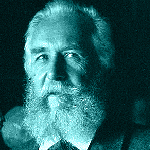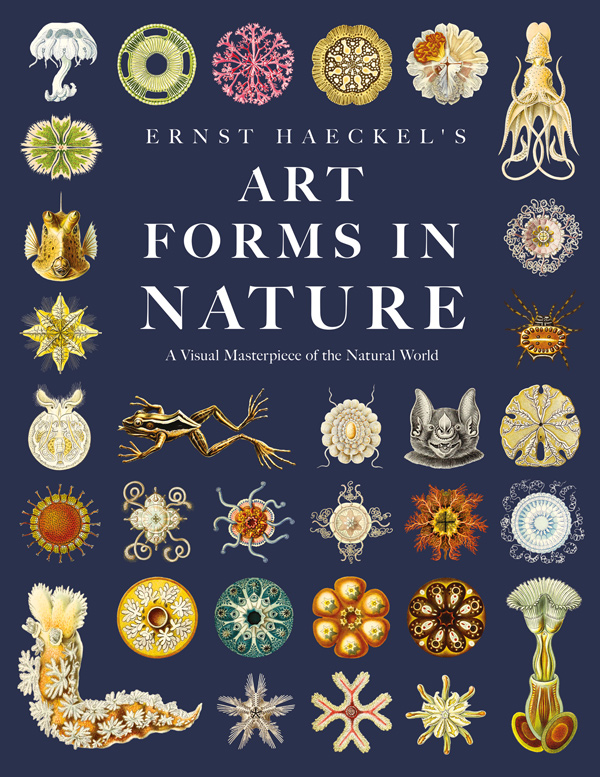
ERNST HEINRICH HAECKEL
1834 – 1919
A German biologist, born at Potsdam on the 16th of February 1834. He studied medicine and science at Würzburg, Berlin and Vienna, having for his masters such men as Johannes Müller, R. Virchow and R. A. Kölliker, and in 1857 graduated at Berlin as M.D. and M.Ch. At the wish of his father he began to practise as a doctor in that city, but his patients were few in number, one reason being that he did not wish them to be many, and after a short time he turned to more congenial pursuits. In 1861, at the instance of Carl Gegenbaur, he became Privatdozent at Jena; in the succeeding year he was chosen extraordinary professor of comparative anatomy and director of the Zoological Institute in the same university; in 1865 he was appointed to a chair of zoology which was specially established for his benefit. This last position he retained for 43 years, in spite of repeated invitations to migrate to more important centres, such as Strassburg or Vienna, and at Jena he spent his life, with the exception of the time he devoted to travelling in various parts of the world, whence in every case he brought back a rich zoological harvest.
As a field naturalist, Haeckel displayed extraordinary power and industry. Among his monographs may be mentioned those on Radiolaria (1862), Siphonophora (1869), Monera (1870) and Calcareous Sponges (1872), as well as several Challenger reports, viz. Deep-Sea Medusae (1881), Siphonophora (1888), Deep-Sea Keratosa (1889) and Radiolaria (1887), the last being accompanied by 140 plates and enumerating over four thousand new species. This output of systematic and descriptive work would alone have constituted a good life’s work, but Haeckel in addition wrote copiously on biological theory. It happened that just when he was beginning his scientific career Darwin’s Origin of Species was published (1859), and such was the influence it exercised over him that he became the apostle of Darwinism in Germany. He was, indeed, the first German biologist to give a whole-hearted adherence to the doctrine of organic evolution and to treat it as the cardinal conception of modern biology. It was he who first brought it prominently before the notice of German men of science in his first memoir on the Radiolaria, which was completely pervaded with its spirit, and later at the congress of naturalists at Stettin in 1863. Darwin himself has placed on record the conviction that Haeckel’s enthusiastic propagandism of the doctrine was the chief factor of its success in Germany. His book on General Morphology (1866), published when he was only thirty-two years old, was called by Huxley, a suggestive attempt to work out the practical application of evolution to its final results; and if it does not take rank as a classic, it will at least stand out as a landmark in the history of biological doctrine in the 19th century. Although it contains a statement of most of the views with which Haeckel’s name is associated, it did not attract much attention on its first appearance, and accordingly, its author rewrote much of its substance in a more popular style and published it a year or two later as the Natural History of Creation (Natürliche Schöpfungsgeschichte), which was far more successful (. . .)
Not content with the study of the doctrine of evolution in its zoological aspects, Haeckel also applied it to some of the oldest problems of philosophy and religion. What he termed the integration of his views on these subjects he published under the title of Die Welträtsel (1899), which in 1901 appeared in English as The Riddle of the Universe. In this book, adopting an uncompromising monistic attitude, he asserted the essential unity of organic and inorganic nature. According to his “carbon-theory,” which has been far from achieving general acceptance, the chemico-physical properties of carbon in its complex albuminoid compounds are the sole and the mechanical cause of the specific phenomena of movement which distinguish organic from inorganic substances, and the first development of living protoplasm, as seen in the Monera, arises from such nitrogenous carbon-compounds by a process of spontaneous generation. Psychology he regarded as merely a branch of physiology, and psychical activity as a group of vital phenomena which depend solely on physiological actions and material changes taking place in the protoplasm of the organism in which it is manifested. Every living cell has psychic properties, and the psychic life of multicellular organisms is the sum-total of the psychic functions of the cells of which they are composed. Moreover, just as the highest animals have been evolved from the simplest forms of life, so the highest faculties of the human mind have been evolved from the soul of the brute-beasts, and more remotely from the simple cell-soul of the unicellular Protozoa. As a consequence of these views Haeckel was led to deny the immortality of the soul, the freedom of the will, and the existence of a personal God.
Haeckel’s literary output was enormous, and at the time of the celebration of his sixtieth birthday at Jena in 1894 he had produced 42 works with 13,000 pages, besides numerous scientific memoirs. In addition to the works already mentioned, he wrote Freie Wissenschaft und freie Lehre (1877) in reply to a speech in which Virchow objected to the teaching of the doctrine of evolution in schools, on the ground that it was an unproved hypothesis; Die systematische Phylogenie (1894), which has been pronounced his best book; Anthropogenie (1874, 5th and enlarged edition 1903), dealing with the evolution of man; Über unsere gegenwärtige Kenntnis vom Ursprung des Menschen (1898, translated into English as The Last Link, 1898); Der Kampf um den Entwickelungsgedanken (1905, English version, Last Words on Evolution, 1906); Die Lebenswunder (1904), a supplement to the Riddle of the Universe; books of travel, such as Indische Reisebriefe (1882) and Aus Insulinde (1901), the fruits of journeys to Ceylon and to Java; Kunstformen der Natur (1904), with plates representing beautiful marine animal forms; and Wanderbilder (1905), reproductions of his oil-paintings and water-colour landscapes.-- Encyclopædia Britannica, Volume 12, 1911



